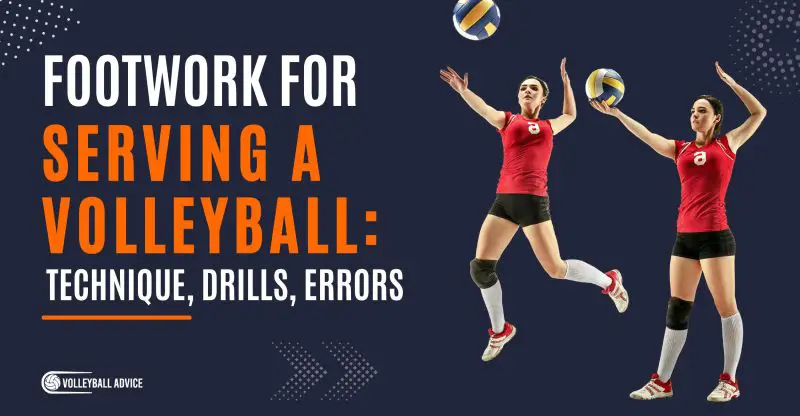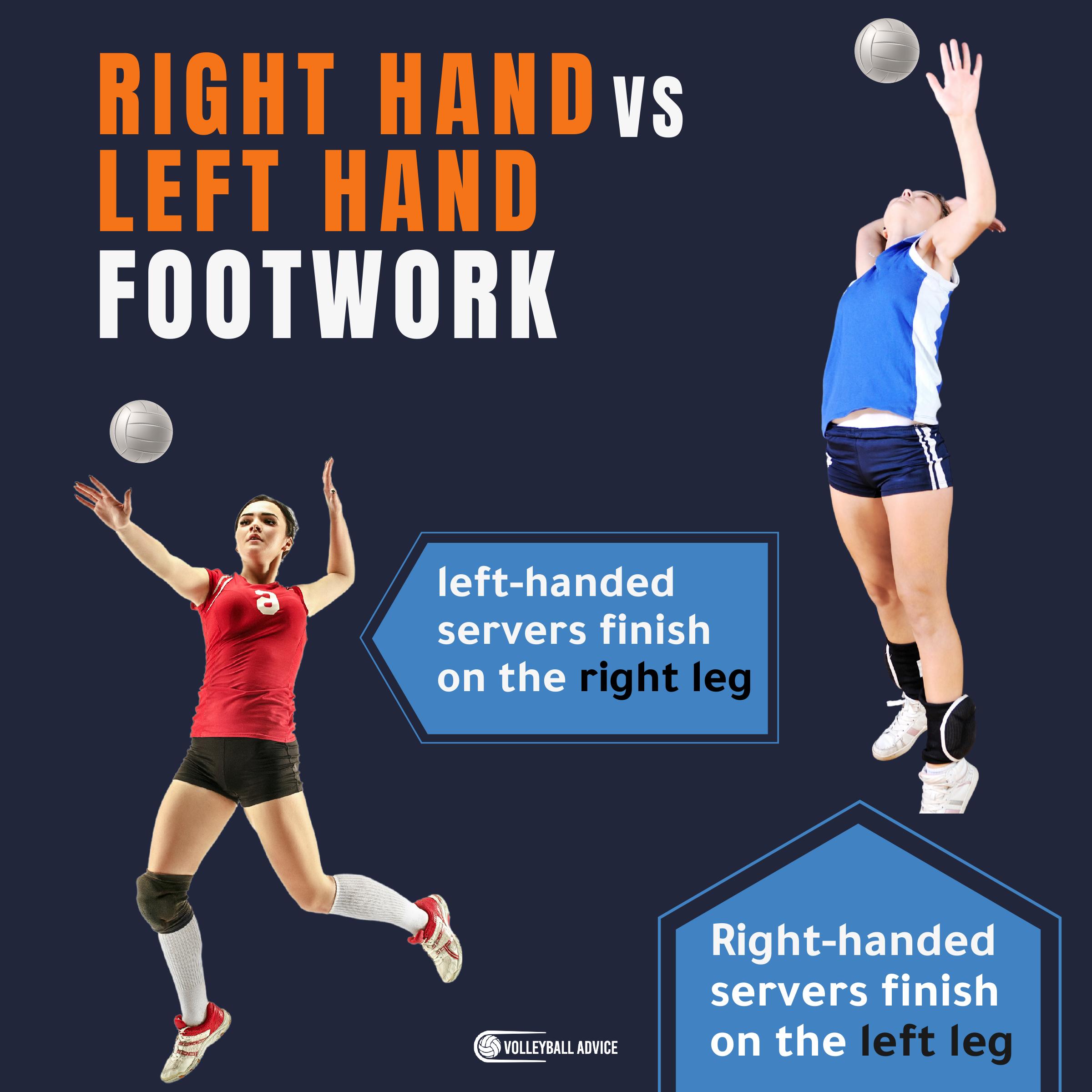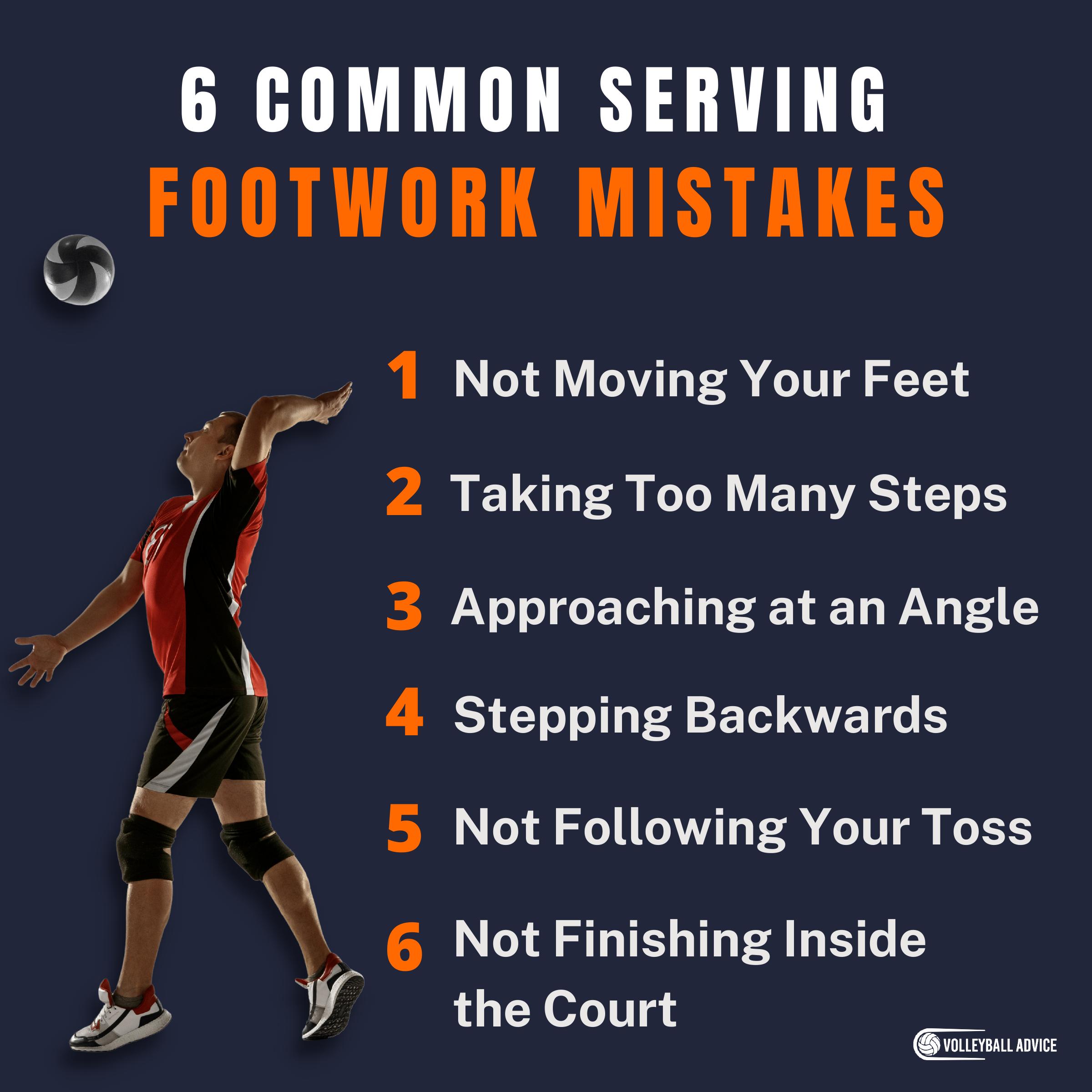Footwork for Serving a Volleyball: Technique, Drills, Errors
Serving in volleyball can be daunting, but great footwork can provide you the skills and confidence you need to succeed.
So, what is the proper footwork for serving a volleyball? Proper footwork for serving a volleyball can be divided into two categories: float serving and topspin serving. Float serving involves stepping forward with the opposite foot to your hitting hand and stepping through the ball as you hit. Topspin serving traditionally uses a three-step approach similar to spiking.
While the focus of serving might appear to be on the arms – where the exciting contact of the ball occurs – the real focus should always be on the feet. The way you step forward and the steps one takes afterward determine how your body moves through the ball and whether or not your positioning allows for a simple yet powerful connection with the serve.
Today, I’m going to be breaking down the footwork for serving and offer some tips to help you become more consistent. By the end of this article, you should be able to:
- Differentiate between good and bad serving footwork
- Serving footwork mistakes players make and how to correct
- Drills to help you master your serving footwork
Proper Footwork For Serving
Serving is the one time in volleyball that you play alone. No one can help you, and whether you put a solid serve into play is entirely reliant on your own skills.
When it comes to footwork for serving, most of it is very simple. Don’t worry though – this is a good thing. As one of the foundational skills for serving, its simplicity can be a great asset to you as a player, providing consistency and rigidity to a serving routine that will train your muscles to serve well each time, every time.
There are many different types of serves, and while the forms might look very different in execution – for instance float serving versus jump float serving, or even hitting a skyball (where you hit the ball as high into the air as possible to cause it to move unpredictably towards the other side of the court) – the footwork remains simple.
The two primary styles of serving, insofar as footwork is concerned, is the float serve and topspin serve.
Float Serve Footwork
First, float serving involves stepping forward with the opposite foot to your hitting hand and stepping through the ball in a straight line as you hit.
Usually, a player’s shoulders should remain square with their hips, knees, and toes from start to finish. This footwork remains the same for any players hitting an underarm serve – sometimes called a “lever shot” because of the way the arm moves.
Whether you take one step or three, the final step must move your body through the ball and into court, giving the ball power. However, most coaches and modern tactics call for as few steps as possible. This decreases the probability of something going wrong or disturbing your serving rhythm and keeps the routine nice and simple.
The only time I believe more than two steps would be necessary to float serve is if any player struggles to generate enough power to serve the ball across the net. An extra step may help generate extra height and power, but be wary of adding too many or allowing your form to lessen, as this will negate any benefits from additional footwork.
Once the basic float serve has been accomplished, a jump float can easily be practiced by adding a forward jump at the end. Practice will be needed to make the changes, so schedule extra time after practice to work on the alterations.
Topspin Serve Footwork
Topspin serving traditionally uses a three-step approach similar to spiking, but also approaches in a straight line towards the toss.
In this instance, a player’s trunk (or torso) will rotate and “prime” itself to swing like a coiled spring. This footwork should never be used for underarm serving, as it is more likely to either fail or allow the server to trip over the ball before hitting.
As with our other footwork, keep the steps to this as efficient and simple as possible, avoiding the addition of any additional steps whenever possible. This will keep the routine as clean and consistent as possible – two essential elements of any stellar serve. Practice without a jump at first, but topspin serving is designed to be hit in the air.
A consistent toss is just as important as the footwork, and without either the other can’t exist.
Use your leg to “stage” the ball before tossing, and aim for the toss to land in the same spot inside the court as much as possible. Walk through the serve a few times, then again with jumping. With enough repetition, the motions will become second nature.
Right Hand vs Left Hand Footwork: Is There a Difference?
When it comes to right handed vs left handed debates in volleyball, there’s always an opposing opinion.
Some coaches train left handed serves differently from right handed serves, while others mold them all the same, no matter what. Whatever you’ve heard, when it comes to footwork it’s all the same – just mirrored.
Just like the footwork for spiking a volleyball, the footwork for serving a volleyball is designed to provide the greatest range of motion and dynamic hitting power to the server as possible. This is done not only to increase the power of the serve, but to improve accuracy as well. This is known as “priming” the body similar to how springs coil and store energy. When the body uncoils, it releases a powerful serve.
Right handed servers always step forward with the left foot when hitting or serving because that turns the hips and shoulders and will help release more power when unwound. Stepping forward with the right foot limits the shoulder motion and puts the body at an awkward angle.
For left handed servers, stepping through with the right foot is preferable for exactly the same reasons. Whatever the footwork for right handed servers is will be reversed for left handed servers, but a good way to remember is that you will be stepping though on the last step – whatever comes before – on the right foot.
Key Takeaway: Right-handed servers finish on the left leg; left-handed servers finish on the right leg.
Check out this guide: Hand Positions for Volleyball Serving (3 Types)
Differences In Footwork For Beach Volleyball
The main challenge as always is the sand. Without solid footing, players have to be much more conscious of where they step and how. For maneuvers that include jumping and landing – such as serving, potentially – the less complicated footwork the better.
Just think of beach volleyball as even more streamlined and efficient than indoors when it comes to footwork and you’ll be on the right path.
This doesn’t mean that there’s less – in fact there’s more per player as it’s necessary to keep one’s feet moving to stay ahead of the sand – but it is always done in a manner that is efficient for the situation at hand.
For serving in beach volleyball, a standing serve – either jumping or standing – is usually the preferred option.
Interestingly, this includes both float and topspin serving, and is one of the only times in volleyball where topspin serving is hit without any approach steps. Exceptions exist and are growing as more players transition from indoors to the beach, but while approach steps may be taken they are mainly avoided.
The risk of practicing inefficient footwork in beach volleyball is even more obvious than in indoor volleyball. Tripping over the sand when players haven’t been moving their feet enough or falling off-balance due to poorly-chosen steps are both footwork issues that may affect serving in beach, causing the player to swing wildly or the ball to fly off-target.
When in doubt on the beach, move your feet.
6 Common Serving Footwork Mistakes & How To Correct
1. Not Moving Your Feet
The biggest mistake I see players making in volleyball – whether it’s for passing, setting, spiking, or serving – is that they don’t move their feet enough.
It’s not enough to toss the ball and hope that it comes to you, or to lean forward expecting that you’ll be able to hit it “good enough” from your interestingly improvised yoga position. Move to the ball, always.
If you find that you’re having trouble moving your feet under pressure, don’t worry – that is a natural side effect of playing at a higher level than you’re used to. The solution is to simply become more comfortable with the level by training quick footwork and quick-firing reflexes with ladder drills, sprints, and consciously thinking “I’m moving now”.
For serving, not moving your feet might also be a symptom of fear of being watched. Having a crowd who are entirely focused on you is not for everyone, even if it’s just groups of parents. Remind yourself that you are the best version of a player you can be, and incorporate little confidence-boosting traditions into your routine until you feel safer in the space. Remember – volleyball should be fun!
2. Taking Too Many Steps
The opposite of the first mistake, this can also be caused by nervousness or anxiety. Taking too many steps will usually get your body mixed up or move you past your toss, resulting in a less-than ideal result.
Incorporate traditions to calm yourself and remember to take efficient steps; no more and no less than is necessary to serve well. If that’s one step for you, then that is perfect. If three, also great. Find what works for you and work from there. No player is the same, and our techniques are meant to help us learn and grow!
3. Approaching at an Angle
Approaching at an angle is a big mistake unless you’re an experienced server.
Stepping away from the center court towards the side after training for hours to hit the way your body is facing will tell your body not to hit back towards court – over your left/right shoulder – but towards the way you’re facing. Subconsciously, you will contact the ball off-center in an attempt to compensate for this.
It’s always best to approach straight towards the center of the volleyball court. That said – there’s nothing really wrong with approaching at an angle, it’s just less efficient.
One of my best friends on the national team used to enjoy running along the baseline and serving a killer float at impossible angles at positions no one thought were reachable for him. In order to do that though, he was forced to violently twist his body and hit in unsustainable positions that very likely hurt his back if he wasn’t stretched properly.
However, he was fine with this and practiced when the mood struck him for months to have a fun, joke serve that was effective that he could pull out of his back pocket. Even for him, when it was time to serve seriously, he always approached the net.
4. Stepping Backwards
Stepping backwards is a big no-no.
It lessens the power that goes into your serve, forces you off balance, and you move into an area that you cannot directly see (aka unsafe). Whenever serving, even in practice, always move forward.
5. Not Following Your Toss
Usually this mistake is performed by accident, but it’s still worth mentioning.
Your toss exists for a reason – to put the ball in a position that will allow you to serve more easily and naturally from: an advantageous position. When players don’t follow their toss – even when it’s off (even to catch), they waste the entire point of having one.
Having a good toss is important, but if your footwork can’t account for when the toss is off that’s even more problematic. Always follow your toss and be able to adapt, and you will become a better player overall.
6. Not Finishing Inside the Court
Lastly, and very importantly, always aim to finish your footwork from serving inside the court. Not enough players do this, and I see servers standing in place and hoping for an ace far too often.
The way I like to punish this while coaching is to pass the ball over on the first pass to the spot they were supposed to be defending. Nine out of ten times it results in a point against them, and the lesson becomes fast learned.
This is part of the theory of efficient movement. As serving and transitioning to defense are both actions that require movement, why not tie them together? Using the momentum generated from serving to help move you into court and in place to help your team defend will not only give you more time but also make you look efficient and professional.
After your last step while serving, whether you jumped or not, it should feel almost like you’re falling forward into court. When jump serving, you literally are falling into court provided you’ve jumped correctly (forward). Catch yourself by taking another step, and move from there to your position for defense.
Other Serving Resources
- 10 Types of Serving In Volleyball
- 4 Tips To Serve Better In Volleyball
- Practicing Volleyball Serving Without A Net
Serving Footwork Drills and Progression
Serving is its own best drill, because it can be done alone and practices a direct skill that is used constantly in matches.
1. Solo Serving Drill
To practice your serving footwork, book a court for at least an hour a week and dedicate at least 20 minutes to just thinking about your footwork and being conscious of how it positions your body in relation to the ball.
As you develop and improve, you’ll notice that the variations lessen and your serves become faster and more accurate, not to mention more comfortable to perform.
2. Around the World Cone Approach Drill
Next, set up a series of cones on both sides of the court. They can be anywhere, and as many or little as you desire.
Move around the court in small sections in its entirety – baseline to sidelines and around again – stopping to serve across the net and aiming for the cones. Focus on maintaining good footwork, and notice how it affects where you can serve. When all the cones have been hit, set them up again and work in the opposite direction.
As you develop, notice how much less time and court length it takes you to hit the cones. Mix up your types of serving, but always approach towards the center of the court.
Other Footwork Resources
- Footwork For Setting A Volleyball: How-To, Tips, Drills
- Footwork For Spiking A Volleyball: How-To, Tips, Drills
About The Author
Ailan Samuel is a writer and athlete who has played volleyball at the university, club, and national level since 2012. He has competed successfully in both beach and indoor competitions, resulting in four silver and two gold medals, and was awarded the Half-Blue while playing in Scotland. He received his MA in English and Medieval History from the University of St Andrews, Scotland, and is currently studying for his MA in Publishing and Creative Writing at Bournemouth University.



